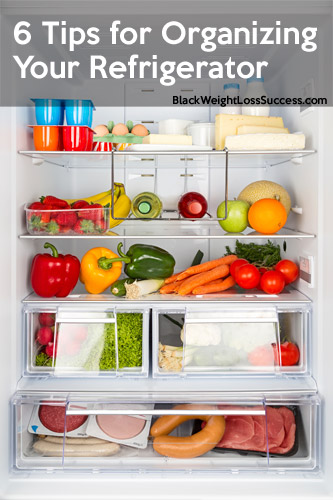The refrigerator is easily the hardest-working appliance in a home, yet it is often neglected. Not only is the average fridge not cleaned often enough but people simply don’t know how to properly organize their foods in the most efficient way. When it comes to organizing your fridge, it isn’t just for the sake of making things neat but to reduce bacteria, keep foods fresh for longer and minimize clutter. Not only is a clean, organized fridge going to keep your foods safe, but it also helps you see what ingredients you have to work with for healthy, balanced meals.
 Here are 6 tips for getting your fridge organized.
Here are 6 tips for getting your fridge organized.
- Don’t Put Things In Your Fridge That Don’t Need to Be Refrigerated
It goes without saying that putting food items in your fridge that don’t need to be chilled can be a major waste of space and can even spoil some foods quicker. Usually, there will be a label on the product saying whether it needs to be refrigerated or refrigerated after opening. Still, many people will put produce, store-bought condiments and foods in their fridge that should be on the counter or in the pantry. Here are a couple examples:
- Tomatoes, Onions and Potatoes
- Fresh Herbs
- Vinegars
- Bread and Bagels
- Some Butters
- Honey
If you are unsure of what foods need to be refrigerated or not, a simple Google search for the item in question will give you answer. Also, most homemade foods and those without preservatives should go into the fridge, even if the store-bought equivalent doesn’t need to be.
- Use Plastic Placemats and Plastic Tubs on the Shelves
Spills are really inevitable in a fridge. To cut down on cleaning time and keep your food safe from bacteria use plastic placemats from your local dollar store as shelf liners. Utilizing square and rectangular plastic tubs will also help you organize foods and is especially helpful for keeping raw meats and any leaks separate from everything else.
- Utilize the Specific Labeled Drawers in Your Fridge Properly
For the most part you will want to follow the label recommendations on the drawers in your fridge. The drawers aren’t just to organize your food but also coincide with temperatures and humidity levels in the refrigerator. For example, the produce drawer is purposely more humid than other parts of the fridge and the meat drawer is colder.
One circumstance in which you may ignore this is if your fridge happens to have a meat drawer higher in the fridge as potential leaks could drip onto food below.
- Put New Groceries Behind Older Food
How often have you cleaned out your fridge to find forgotten leftovers or barely used food that was pushed to the back? To cut down on waste make sure you put new groceries behind food that’s already in your fridge. As for leftovers, placing them in an obvious spot at the front as a regular habit will help you make sure it gets eaten or tossed in an appropriate amount of time.
- Organize Foods From Top to Bottom and Front to Back
The way a refrigerator is built and the way it chills food is important to know. The top shelf of your fridge is the warmest shelf, the bottom shelf or drawers are the coldest. The warmest place in your fridge are the shelves on the door. Also, the back of each shelf is colder than the front. As an example of organizing, cooked food should go on the top shelves, milk on the bottom shelf closet to the back, and condiments and sauces on the door. This is also a matter of preference, but be mindful of the temperatures.
- Clean The Inside and Outside of Your Fridge Before Grocery Shopping
Keeping your fridge clean is extremely important in removing bacteria to keep your food safe. Many refrigerators aren’t cleaned nearly enough as they should and sometimes people go months without a deep cleaning. One study done by Microban Europe showed that the salad drawer of 30 different fridges showed an average of nearly 8,000 units of bacteria per square centimeter. Some samples were much higher.
It goes without saying that any spills should be cleaned immediately, but you should also wipe down the inside and outside of your fridge door before you go grocery shopping weekly or monthly. At the very least, clean out any foods that have gone bad or spoiled. A deep cleaning should be done every 3 months. It’s hard to keep track of things when you have a big family or a dealing with kids, but cleaning will help your appliance to last and serve your family well.
Your fridge deserves some extra TLC compared to other appliances. Setting reminders for quarterly deep cleanings and making it a habit to clean out your fridge before putting in new groceries is the key to banishing bacteria.

Comment Via Facebook